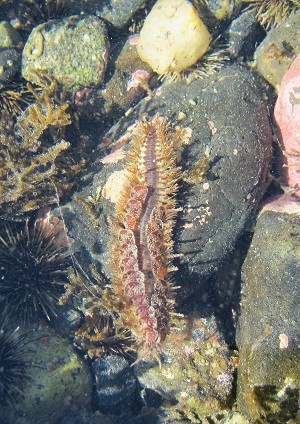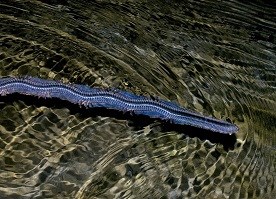
Among the barnacles on rocks in the low to middle intertidal zones, you might spot long, thin worms that are smooth and often dark green or white in color. In muddy areas, similar purple worms are common. These are ribbon worms or Nemerteans. They have an extendable proboscis that measures up to half the length of their bodies. At the end of the proboscis in most species is a stinging barb attached to a poison gland. Ribbon worms are predators. The green ribbon worm (Emplectonema), which usually has a light underbody, specializes on a diet of barnacles which it stings and paralyzes when the barnacle’s plates are open to feed. The purple species (Paranemertes) and likely the white species (Amphiporus) feed primarily on other worms, such as the mussel worm. It is sometimes possible to elicit an attack by the purple ribbon worm by placing a mussel worm nearby in a pool of water. Although the mussel worms can be much larger, and have powerful jaws, the ribbon worm is often successful in paralyzing it with its strike. Polychaetes, relatives of the earthworm, are found in just about every type of marine environment from the intertidal zone to the deepest parts of the ocean. There are many species of these segmented worms in the Bartlett Cove area but most are buried in the mud and are difficult to observe. Many of the small holes you see in the mud at low tide are the openings of worm burrows, some of which are elaborate sand and mucus structures. 
Identifying worms is an ambitious undertaking. However, there are a few polychaetes which are easily recognized. The most conspicuous, and by far the prettiest, are the feather duster worms. Feather duster worms are sessile tube-dwelling polychaetes, meaning they remain fixed in one place. They feed by filtering plankton from the water with their flower-like tentacles. They can be recognized when feeding because they instantly withdraw their tentacles when disturbed. All other flower-like invertebrates withdraw more slowly. Clusters of their straight parchment-like tubes (Eudistylia) can often be seen at low tide in crevices in rocky areas or under the overhangs of large rocks. Another kind of feather duster worm, the tiny Spirorbis, can be found in great numbers on the undersides of rocks. These have white spiraled calcareous tubes, and the bright red tentacles of the worm may be visible. Another group of polychaetes likely to be seen are scale worms, which can be identified by the two rows of plate-like scales running down the back. Some members of the group provide excellent examples of what ecologists call commensalism. Although many are free-living, a number of scales worms live closely with other marine animals. For example, some are found only in the burrows of other host worms or clams. Others live only in grooves on the undersides of starfish or on the bodies of large sea cucumbers or in the gills of chitons. A commensal relationship is beneficial to one of the two organisms involved (in these cases the scale worm) but doesn’t harm or benefit the host. The mussel worm (Nereis) may grow up to three feet in length. As in most segmented worms each segment has a pair of paddle-like appendages which aid in movement. They have powerful jaws, and may bite when mistreated. Look for them in the middle and lower zone mussel beds. |
Last updated: January 13, 2022
